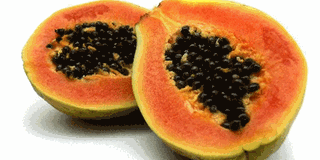Experts reveal why some pawpaws are sweeter than others

Pawpaw fruit. NATION MEDIA GROUP
What you need to know:
- Sweetness in fruit evolved for good reason which is to attract animals that can feed on it and therefore cause dispersal of seeds in the fruit.
Last week, there was a heated debate in the newsroom about pawpaws. The pawpaw, also known as papaya in English and mpapai (the tree) and papai (the fruit) in Swahili, is considered one of Kenyan scientists' most important fruit plants. Its scientific name is Carica papaya.
The pawpaw originated in lowland areas of Central and South America. Still, over the years, it has been cultivated in most warm regions of the world.
Fresh fruits are essential sources of vitamins, minerals, and dietary fibre, crucial in food security and human nutrition.
Journalists at the Nation's Health Desk debated which pawpaw was the sweetest and most nutritious. They wanted to know which one to recommend to their readers.
"Nipe ile tamu kabisaa" is what you are likely to say to your 'Mama Mboga' when buying a fruit.
I asked an expert which pawpaw was the sweetest and most nutritious. After all, who doesn't love healthy sweet things?
Jackson Makori, a fruit vendor in Gachie, Kiambu County, has been selling fruit for 15 years. He says that, as far as he knows, the sweetest pawpaws are found in Meru and Kitui counties.
Dr Patrick Maundu, a Kenyan ethnobotanist who has dedicated his life to the research of indigenous knowledge on African biodiversity in health and nutrition gave some pointers.
"Sweetness in fruit evolved for good reason which is to attract animals that can feed on it and therefore cause dispersal of seeds in the fruit," said Dr Maundu who has been with the National Museums of Kenya since 1989 and now heads the Kenya Resource Centre For Indigenous Knowledge (Kenrik).
"When you cut the pawpaw and find that it has no seed, that's most likely a male fruit. They are usually seedless and not sweet because sweetness will not serve any function," Dr Maundu said.
"Pawpaw trees exist in three forms: female, male, and self-pollinating or hermaphrodite, hence regarded as trioecious. Female plants require pollen from male or self-pollinating plants, but male plants are more effective at passing their pollen to female flowers," he says.
"Self-pollinating plants tend to have the sweetest fruits because they don't rely on pollen from elsewhere and are, therefore, the most effective in propagating the species. Pollen is mainly brought by wind or insects.
The ethnobotanist explains that hermaphrodite plants have both female and male parts in the same flower, and the fruit tends to have a pear shape.
According to Dr Maundu, male pawpaw trees are easier to pick out from pawpaw plants than bisexual and female ones.
This is because their flowers are slender, with most having one long, pendulous stalk.
"They lack the female parts, or the pistil with stigma, except in a few cases of pistil-bearing flowers at the farthest flowers. Female pawpaw plants, on the other hand, have fewer but larger flowers that are borne singly or in small clusters," the expert notes, adding that their stalks are short, so they cluster next to the pawpaw plant.
Dr Maundu says his study of the plant has found that Kenyan farmers prefer the self-pollinating pawpaw, even if they don't know it.
This is not only because they are the sweetest but also because they are more productive in terms of yields, as every tree will produce fruit.





